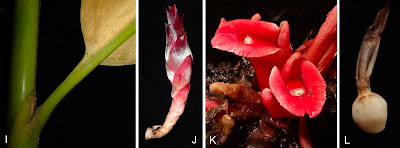 |
| Etlingera densiuscula (Valeton) R. M. Sm., Etlingera grandiflora (Valeton) R. M. Sm. Etlingera vestita (Valeton) R. M. Sm. in Poulsen, Pomoso & Magun, 2022. DOI: 10.3372/wi.52.52201 |
Abstract
The German botanist, F. R. R. Schlechter, collected three species of Etlingera around 1907 in “Kaiser-Wilhelmsland”, now the northern part of Papua New Guinea. Based on these collections, Valeton described three new species in 1914 in Geanthus, but the types collected by Schlechter kept in the Berlin Herbarium were lost during the Second World War. Using a map published by Schlechter in 1911, it was possible to pin down where the types had been collected, and during fieldwork in November 2019 these species were recollected near their type localities. Two of the species had meanwhile been collected from several other places in Papua New Guinea. The current paper includes much improved descriptions and illustrations (ink drawings and a plate with colour photographs) of the three species. Lectotypes are designated for E. densiuscula and E. grandiflora and a neotype is designated for E. vestita.
KEYWORDS: Etlingera, Geanthus, Papua New Guinea, Rudolf Schlechter, Typification, Valeton, Zingiberaceae
 |
| A–D: Etlingera densisucula; A: pseudostem with ligule and leaf base; B: inflorescence; C: labellum, stamen and stigma; D: infructescence. A–D: Poulsen & al. 3189. Photographs by Axel Dalberg Poulsen. |
Tracing Etlingera collections made by Schlechter
1. Etlingera densiuscula (Valeton) R. M. Sm. in Notes Roy. Bot. Gard. Edinburgh 43: 244. 1986
≡ Geanthus densiusculus Valeton in Bot. Jahrb. Syst. 52: 56. 1914.
Etymology — The specific epithet means “moderately dense”, possibly referring to the flower head.
Vernacular name and uses —mbsang (Amung language, Poulsen & al. 3189), no uses informed, tastes sour-aromatic similar to Etlingera elatior (Jack) R. M. Sm.; momo waimamo (Nabak language, Poulsen & al. 3129), used as substitute for betel nut (Areca cathechu L.).

2. Etlingera grandiflora (Valeton) R. M. Sm. in Notes Roy. Bot. Gard. Edinburgh 43: 245. 1986
≡ Geanthus grandiflorus Valeton in Bot. Jahrb. Syst. 52: 56. 1914.
Etymology — The specific epithet means “large flowered” and Valeton (1914) emphasized the large flowers as a diagnostic character compared to other species from New Guinea that he knew at the time.
Vernacular name and uses — saru (Amung language, Poulsen & al. 3191), no uses informed.
3. Etlingera vestita (Valeton) R. M. Sm. in Notes Roy. Bot. Gard. Edinburgh 43: 250. 1986
≡ Geanthus vestitus Valeton in Bot. Jahrb. Syst. 52: 55. 1914.
Etymology — The specific epithet means “clothed” and Valeton (1914) was probably referring to the densely silky-haired, almost felted, abaxial surface of the leaf blade.
Vernacular name and uses — mbsang (Amung language, Poulsen & al. 3190), no uses informed, tastes slightly bitter; sukur yaulib or sukur pai (Aiku language; saingil means long, Poulsen & al. 3063), no uses informed, lamina smells of chocolate.
Axel Dalberg Poulsen, Philip Pomoso and Thomas Magun. 2022. Three Species of Etlingera (Zingiberaceae) recollected in the Footsteps of Rudolf Schlechter in Papua New Guinea. Willdenowia. 52(2); 153-165. DOI: 10.3372/wi.52.52201





